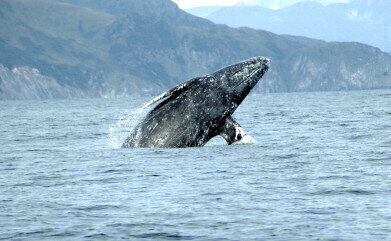Fuel for Thought
How Will Shell’s Arctic Drilling Affect the Local Wildlife?
Jun 23 2015
As Shell gears up to launch its latest Arctic exploratory drilling project environmentalists are in uproar. Not only will the rig have devastating climatic consequences but they also maintain drilling, seismic testing and ice-breaking activities will harass thousands of whales, seals and other marine life residing in the area.
Deafening consequences
One of the biggest concerns is the disruptive underwater sounds that will echo throughout the region. Tim Donaghy, senior research specialist with Greenpeace stresses that “a deaf whale is a dead whale” and that by going ahead with the drilling, Shell is issuing thousands of gentle giants with a death sentence. As well as the risk of injury the sounds are likely to disturb natural behavioural patterns such as breathing, migrating, breeding, feeding, nursing and sheltering.
Christopher Krenz, a scientist and Arctic campaign manager with Oceana explains, “If the noises happen and whales are caught within that zone, it can cause hearing damage. These whales talk to each other. Scientists think that it is very important for cows and calves to call out to each other as they migrate.”
Shell fesses up
Even Shell itself has admitted that the project will be disruptive to native wildlife, as outlined in an application document filed to the National Marine Fisheries Service. The document highlighted some of the major disruptions to come, including the fact that over 2,500 bowhead whales, 2,500 gray whales and 50,000 ringed seals will be exposed to continuous sounds and pulsed vibrations that are considered damaging and debilitating to their existence.
‘Tolerable’ harassment?
The US Marine Mammal Protection Act permits the ‘harassment’ of animals under the condition that it affects a small portion of the population and has a negligible impact on the species as a whole. Of course, Shell maintains that the effects of its Arctic drilling project will fall into this category. Activists on the other hand disagree. The document states that an estimated 13% of the world’s total bowhead whale population will be harassed, as well as 13% of gray whales and 16% of ringed seals.
Krenz argues that “The authorisation that they [Shell] are seeking is a request to be able to harass that amount of animals. Shell has asked the government to authorize the taking of that amount of animals.”
According to Shell its in-house environmentalists will actively monitor at-risk areas where loud and damaging activities will be carried out. Should any whales be sighted the company claims it will halt activities. But is this enough? For environmentalists, definitely not. Even without the impact of deafening sounds drilling still poses as a serious oil spill threat, with a recent government study revealing that the chances of one or more serious Arctic oil spills over the next 77 years is as high as 75%.
Want to know more about the oil industry and the impact it's having on whales? This insightful article looks at the situation in Russia's Far East and explores how drilling is putting the live's of the regino's gentle giants at risk.
Image via Wikipedia
Digital Edition
PIN 25.1 Feb/March
March 2024
In This Edition Safety - The technology behind the ION Science Tiger XT - Safety with ammonia and LOHCs as hydrogen carriers Analytical Instrumentation - Discussion on new tribology te...
View all digital editions
Events
Apr 28 2024 Montreal, Quebec, Canada
Apr 30 2024 Birmingham, UK
May 03 2024 Seoul, South Korea
May 05 2024 Seville, Spain
May 06 2024 Riyadh, Saudi Arabia


















